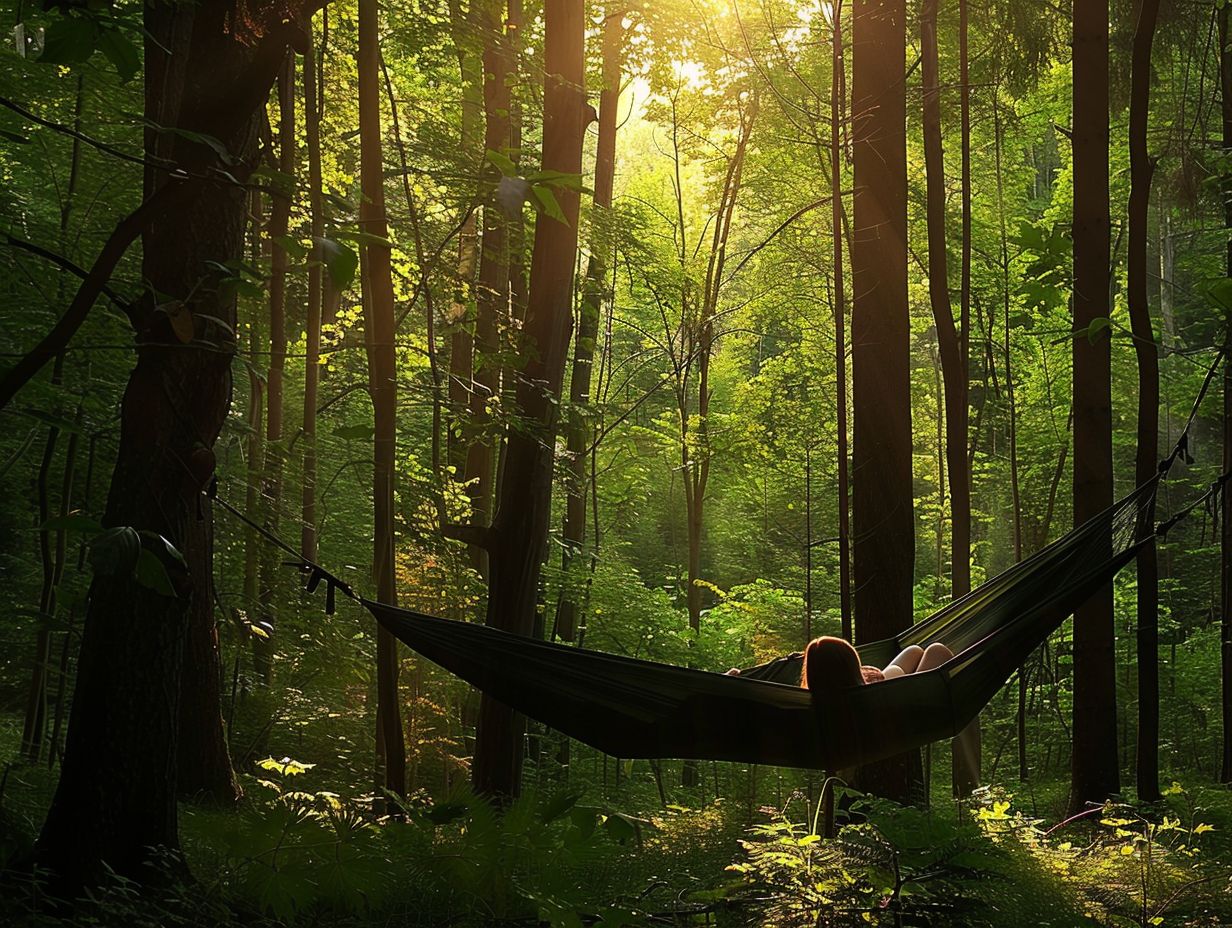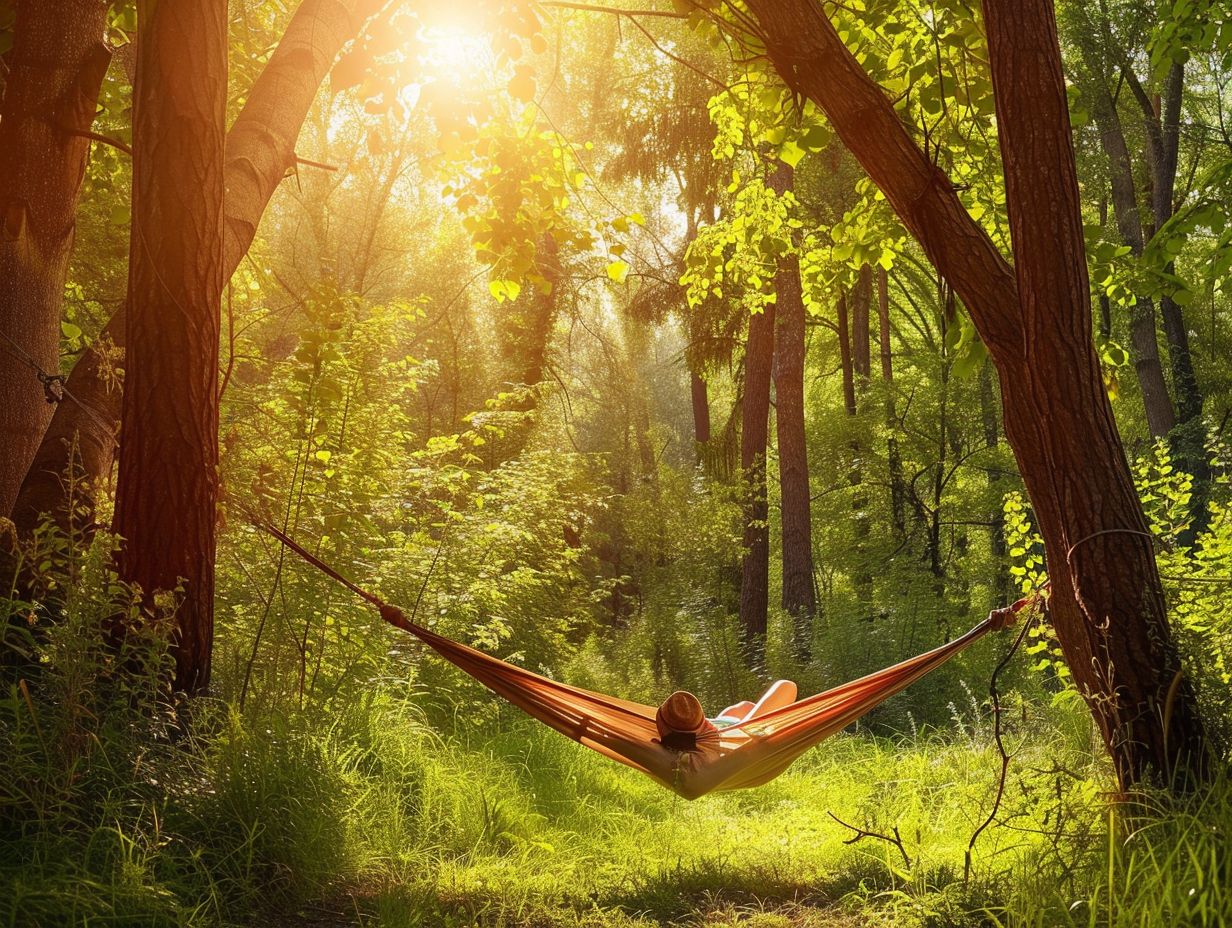Consider upgrading your camping experience with a camping hammock!
We explore the benefits of using a camping hammock, such as better sleep quality, improved posture, and spinal alignment.
Learn what to consider when choosing a camping hammock, how to set it up properly, and the convenience it offers for your outdoor adventures.
Grab a cup of coffee, sit back, and let’s dive into the world of camping hammocks together!
Key Takeaways:

- Experience more comfortable and restful sleep during camping trips with a camping hammock.
- Enjoy the versatility and convenience of a lightweight and portable hammock while also reducing your environmental impact.
- Improve your sleep quality, protect yourself from ground hazards, and find relaxation and stress relief by using a camping hammock.
Why Use a Camping Hammock?
Camping hammocks have experienced a significant increase in popularity among outdoor enthusiasts due to their distinct advantages in hammock camping. They provide unmatched comfort, versatility, and lightweight, space-saving benefits, making them an attractive alternative to conventional tent camping.
1. More Comfortable Sleeping
One of the principal advantages of hammock camping is the improved quality of sleep it provides, made possible by features such as diagonal sleeping positions and customisable ridgeline setups.
Diagonal sleeping in a hammock enables a more level surface, reducing pressure points and encouraging a natural alignment of the spine. The flexibility of hammocks allows users to modify the sag and firmness of the fabric, accommodating individual preferences for a comfortable rest.
To address cold temperatures during the night, underquilts can be easily affixed beneath the hammock, offering insulation to retain body heat and ensure warmth and comfort. These ergonomic advantages contribute to a peaceful and revitalising sleep experience, establishing hammock camping as a favoured option among outdoor enthusiasts.
2. Versatility and Convenience
Hammocks offer exceptional versatility and convenience, allowing users to create not only a sleeping area but also a comfortable seating arrangement, making them highly adaptable to various camping scenarios.
The simplicity of transitioning a hammock from a bed to a chair enhances its appeal; by adjusting the hanging straps or incorporating accessories such as cushions, a cosy seating space can be effortlessly established.
Available in a range of materials, sizes, and features, hammocks provide campers with the flexibility to select based on individual preferences.
Whether one requires a lightweight travel hammock for backpacking expeditions or a robust, weather-resistant hammock for prolonged camping ventures, there exists a hammock variant suitable for every adventurer’s requirements.
3. Lightweight and Portable
Hammocks present a lightweight and compact alternative for campers, offering high portability and ease of transportation in comparison to conventional tents.
Their efficient design enables quick folding and packing into a rucksack without occupying considerable space, rendering them well-suited for hikers and backpackers aiming to reduce weight and optimise efficiency.
The weight efficiency of hammocks not only facilitates a comfortable and elevated sleeping arrangement but also eliminates the bulk associated with conventional sleeping systems. The straightforward setup process of hammocks further enhances their appeal, particularly among individuals seeking a convenient and uncomplicated camping experience.
4. Better for the Environment
Utilising a camping hammock can result in a reduced environmental impact compared to traditional tents, as they adhere to the Leave No Trace principles and typically require only trees and straps for installation.
By employing trees as anchor points and straps for support, hammocks allow campers to elevate themselves above the ground, thereby minimising their impact on the surrounding vegetation and soil. This method diminishes the necessity to clear or level ground, thus conserving the natural landscape.
Furthermore, hammocks leave minimal trace once dismantled, unlike tents that may leave behind flattened patches of grass or disturbed soil. This environmentally conscious characteristic of hammock camping resonates positively with outdoor enthusiasts who are dedicated to minimising their ecological footprint.
What to Consider When Choosing a Camping Hammock?
Selecting the optimal camping hammock requires a thorough evaluation of various critical factors, including:
- the quality of material and durability,
- dimensions and weight capacity,
- simplicity of assembly and disassembly, and
- any additional features that could enhance the overall camping experience.
1. Material and Durability

When choosing a camping hammock, it is essential to carefully consider the material and durability. Popular options in the market include the Hennessey Hammock and the Grand Trunk Double Parachute, both of which are recognised for their sturdy construction.
These premium hammocks are specifically engineered to withstand the challenges of outdoor expeditions, ensuring a combination of longevity and comfort for the users. The selection of materials, such as ripstop nylon or high-tenacity polyester, used in the construction of hammocks plays a significant role in determining their overall performance.
For example, the Hennessey Hammock is meticulously crafted from robust fabrics capable of enduring rough terrains and adverse weather conditions, making it a dependable choice for camping enthusiasts.
In a similar vein, the Grand Trunk Double Parachute showcases the use of strong parachute nylon, which offers a balance of durability and lightweight portability, making it particularly suitable for backpacking endeavours.
2. Size and Weight Capacity
The dimensions and weight capacity of a camping hammock are critical factors to consider, as they determine its ability to comfortably support the user’s body size and weight, as well as any accompanying gear and accessories. Having a camping hammock that is appropriately sized and has the right weight capacity is imperative for ensuring a relaxing and safe outdoor experience.
When selecting the correct size, it is important to evaluate both the length and width of the hammock to guarantee ample space for the user’s body.
Moreover, the weight capacity of the hammock is crucial for bearing the user’s weight and any additional equipment or items. It is essential to calculate the total weight of the user(s) and all supplementary items that will be placed in the hammock to avoid surpassing the weight limit.
Considering all elements involved in the hammock setup, including straps, carabiners, and rainfly, is essential for establishing a secure and stable camping environment.
3. Ease of Set-up and Take-down
One crucial element to take into account is the convenience of setup and take down, as a shorter setup duration and lower learning curve can significantly enhance the camping experience.
A fast and effective setup procedure not only saves time but also minimises frustration, enabling individuals to devote more time to enjoying the outdoor environment.
When choosing a camping hammock, it is advisable to seek user-friendly systems such as adjustable suspension straps or integrated karabiners.
Before embarking on a camping journey, it is recommended to practise setting up the hammock at home to become acquainted with the process.
In locations where traditional hanging options are restricted, it may be worthwhile to consider acquiring lightweight yet robust hammock stands.
These minor preparations have the potential to yield substantial benefits in the overall camping experience.
4. Additional Features
The incorporation of additional features such as customisation options, insulation elements like underquilts, and weather protection components like tarps can significantly enhance the functionality and comfort of your camping hammock.
Customisation options offer individuals the chance to customise their camping hammock in line with personal preferences, whether that involves colour selection, size specifications, or adding extra storage pockets.
Underquilts serve to provide insulation beneath the hammock, ensuring warmth and comfort during colder evenings. Tarps act as a reliable form of weather protection, effectively shielding users from rain or intense sunlight exposure.
By investing in a hammock that includes these features, individuals not only improve their camping adventures but also prepare themselves adequately for a range of outdoor conditions.
What Are the Benefits of Using a Camping Hammock?
The utilization of a camping hammock presents a multitude of advantages, encompassing:
- Enhanced sleep quality
- Safeguarding against ground hazards
- Promoting better posture and spinal alignment
- Facilitating relaxation
- Providing cost-effective solutions
Rendering it a superior option for a substantial number of campers.
1. Better Sleep Quality
One of the primary advantages of hammock camping is the enhanced quality of sleep it offers, which is achieved through increased comfort and the option to sleep diagonally. Sleeping in a diagonal position in a hammock enables a flatter surface, which can reduce pressure points and improve spinal alignment, ultimately leading to a more restful sleep experience.
Additionally, the gentle sway of a hammock can aid in inducing deeper and more peaceful sleep by simulating a rocking motion that many individuals find calming. The elevation and suspension of a hammock can help alleviate typical sleep disruptions caused by uneven or rocky terrain, creating a more stable and tranquil setting that is conducive to a night of quality rest.
2. Protection from Ground Hazards
Camping hammocks offer valuable protection against ground-related hazards, such as animals and uneven terrain, thereby improving the comfort and safety levels of your camping experience.
By suspending individuals above ground level, hammocks function as a barrier that shields them from potential encounters with crawling creatures, as well as sharp rocks or roots. This elevated positioning not only enhances safety but also contributes to a quieter sleeping environment.
The versatile nature of hammocks enables users to set them up on various types of terrain, including rocky, muddy, or sloped surfaces, thereby providing a stable and level platform for relaxation. This adaptability ensures that individuals can enjoy a tranquil night’s rest without concerns regarding discomfort or safety risks associated with ground conditions.
3. Improved Posture and Spinal Alignment
An adequately arranged camping hammock can notably enhance posture and spinal alignment, consequently improving the quality of sleep and comfort experienced during camping trips.
The hammock’s gentle cradle-like structure effectively supports the spine’s natural curvature, thereby diminishing pressure points and fostering correct alignment. Through the even distribution of weight, hammocks play a role in mitigating back pain and stiffness.
This ergonomic positioning also contributes to a reduction in tension in the neck and shoulders, facilitating relaxation and quicker onset of sleep. Consequently, individuals camping in hammocks are more likely to awaken feeling rejuvenated and invigorated after a restful night’s sleep.
4. Relaxation and Stress Relief
Hammocks are recognised for their capacity to offer relaxation and stress relief, rendering them a superb choice for enhancing camp comfort during outdoor excursions.
The gentle swaying motion experienced while reclining in a hammock can assist in alleviating muscle tension and inducing a sensation of weightlessness that enables the body to fully unwind.
The calming movement of being cradled in a hammock simulates the sensation of being gently rocked to sleep, fostering a deeper state of relaxation.
This level of comfort and support can yield a substantial impact on the quality of sleep experienced while camping, facilitating a refreshed awakening and a readiness to engage in the day’s activities.
5. Cost-Effective Option

Hammock camping presents a cost-effective alternative that brings forth numerous benefits, rendering it an economical option for individuals seeking to enrich their outdoor experiences while being mindful of their expenditure.
When compared to conventional camping gear like tents and sleeping bags, hammock setups tend to be more economically viable, allowing outdoor enthusiasts to partake in nature-related activities without incurring a considerable financial burden.
Moreover, in addition to the cost-effectiveness, hammock camping also offers the advantage of being lightweight and portable, simplifying the packing and transportation process especially during hiking or backpacking excursions.
The adaptability of hammocks further permits campers to establish their sleeping quarters across diverse terrains, ranging from rugged surfaces to uneven ground, thereby ensuring a comfortable and secure rest regardless of the adventure’s location.
Frequently Asked Questions
What are the benefits of using a camping hammock?
There are several benefits to using a camping hammock, including:
- Lightweight and compact, making it easy to carry and transport
- Elevated sleeping position, providing a more comfortable and ergonomic rest
- Versatile, as it can be used for sleeping, lounging, or as a makeshift chair
- Keeps you off the ground, away from bugs, rocks, and uneven terrain
- Can save space and weight in your camping gear compared to a traditional tent
- Allows you to sleep in unique and picturesque locations that may not be suitable for a tent
Can anyone use a camping hammock?
Yes, camping hammocks are suitable for people of all ages and abilities, as long as they are set up correctly and used safely. They are a popular choice for solo travelers, couples, and families.
How do I set up a camping hammock?
Setting up a camping hammock is relatively simple and can be done in a few steps:
- Find two sturdy anchor points, such as trees, that are at the right distance apart
- Attach the hammock straps to the anchor points, making sure they are secure and at the correct height
- Hang the hammock on the straps and adjust the tension until it is taut
- Test the hammock to make sure it is secure and adjust as needed
- Get in and enjoy!
Are camping hammocks safe?
When set up and used correctly, camping hammocks are generally safe. However, it is essential to follow safety guidelines, such as using appropriate straps and checking the anchor points for stability. It is also crucial to practice proper use, such as getting in and out of the hammock correctly and not exceeding its weight limit.
How do I choose the right camping hammock for me?
When choosing a camping hammock, consider factors such as your budget, intended use, weight capacity, and desired features, such as bug nets or rainfly. It is also essential to read reviews and do research to find a reputable and high-quality brand.

